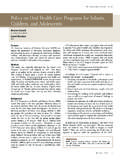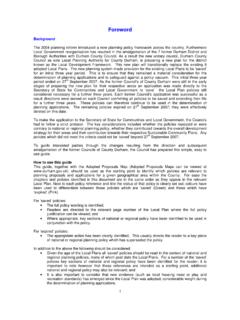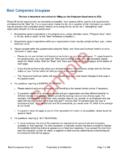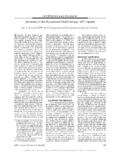Transcription of Guideline on Management of Acute Dental Trauma
1 REFERENCE MANUAL V 34 / NO 6 12 / 13. Guideline on Management of Acute Dental Trauma Originating Council Council on Clinical Affairs Review Council Council on Clinical Affairs Adopted 2001. Revised 2004, 2007, 2010, 2011. Purpose The AAPD encourages the use of protective gear, The American Academy of Pediatric Dentistry (AAPD) intends including mouthguards, which help distribute forces of im- these guidelines to define, describe appearances, and set forth pact, thereby reducing the risk of severe ,13. objectives for general Management of Acute traumatic Dental Dental injuries could have improved outcomes if the injuries rather than recommend specific treatment procedures public were aware of first-aid measures and the need to seek that have been presented in considerably more detail in text- immediate Because optimal treatment results fol- books and the Dental /medical literature.
2 Low immediate assessment and care,18 dentists have an ethical obligation to ensure that reasonable arrangements for emer- Methods gency Dental care are The history, circumstances This Guideline is an update of the previous document revised of the injury, pattern of Trauma , and behavior of the child in 2007. It is based on a review of the current Dental and and/or caregiver are important in distinguishing nonabusive medical literature related to Dental Trauma . An electronic injuries from search was conducted using the following parameters: Terms: Practitioners have the responsibility to recognize, differen- teeth , Trauma , permanent teeth , and primary teeth ; tiate, and either appropriately manage or refer children with Fields: all; Limits: within the last 10 years, humans, English.
3 Acute oral traumatic injuries, as dictated by the complexity of There were 5269 articles that matched these criteria. Papers the injury and the individual clinician's training, knowledge, for review were chosen from this list and from references and experience. Compromised airway, neurological manifesta- within select articles. In addition, a review of the journal Den- tions (eg, altered orientation), hemorrhage, nausea/vomiting, or tal Traumatology was conducted for the years 2000-2009. suspected loss of consciousness requires further evaluation by When data did not appear sufficient or were inconclusive, a physician.
4 Recommendations were based upon expert and/or consensus To efficiently determine the extent of injury and correctly opinion including those from the 2008 AAPD Symposium diagnose injuries to the teeth, periodontium, and associated on Trauma : A Comprehensive Update on Permanent Tooth structures, a systematic approach to the traumatized child is es- Trauma in Children (Chicago, Ill.). The recommendations are ,22 Assessment includes a thorough medical and Dental congruent with the 2007 guidelines developed by the Interna- history, clinical and radiographic examination, and additional tional Association of Dental tests such as palpation, percussion, sensitivity, and mobility evaluation.
5 Intraoral radiography is useful for the evaluation of Background dentoalveolar Trauma . If the area of concern extends beyond Facial Trauma that results in fractured, displaced, or lost teeth the dentoalveolar complex, extraoral imaging may be indica- can have significant negative functional, esthetic, and psycho- ted. Treatment planning takes into consideration the patient's logical effects on ,5 Dentists and physicians should health status and developmental status, as well as extent of collaborate to educate the public about prevention and treat- injuries.
6 Advanced behavior guidance techniques or an appro- ment of traumatic injuries to the oral and maxillofacial region. priate referral may be necessary to ensure that proper diagnosis The greatest incidence of Trauma to the primary teeth and care are given. occurs at 2 to 3 years of age, when motor coordination is All relevant diagnostic information, treatment, and recom- The most common injuries to permanent teeth mended follow-up care should be documented in the patient's occur secondary to falls, followed by traffic accidents, violence, record. A standardized Trauma form23 can guide the practi- and All sporting activities have an associated risk of tioner's clinical assessment and provide a way to record the orofacial injuries due to falls, collisions, and contact with hard essential aspects of care in an organized and consistent manner.
7 230 CLINICAL GUIDELINES. AMERICAN ACADEMY OF PEDIATRIC DENTISTRY. Well-designed and timely follow-up procedures are essential 4. use chlorhexidine/antibiotics if prescribed;. to diagnose and manage complications. 5. call immediately if splint breaks/loosens. After a primary tooth has been injured, the treatment strat- egy is dictated by the concern for the safety of the permanent Recommendations ,21,24 If determined that the displaced primary tooth Infraction has encroached upon the developing permanent tooth germ, Definition: incomplete fracture (crack) of the enamel without removal is ,6,25-29 In the primary dentition, the max- loss of tooth structure.
8 Illary anterior region is at low risk for space loss unless the Diagnosis: normal gross anatomic and radiographic appear- avulsion occurs prior to canine eruption or the dentition is ance; craze lines apparent, especially with transillumination. Fixed or removable appliances, while not always Treatment objectives: to maintain structural integrity and pulp necessary, can be fabricated to satisfy parental concerns for ,41,42. esthetics or to return a loss of oral or phonetic General prognosis: Complications are When an injury to a primary tooth occurs, informing parents about possible pulpal complications, appearance of a Crown fracture uncomplicated vestibular sinus tract, or color change of the crown associated Definition: an enamel fracture or an enamel-dentin fracture with a sinus tract can help assure timely intervention, mini- that does not involve the pulp.
9 Mizing complications for the developing succedaneous Diagnosis: clinical and/or radiographic findings reveal a loss ,6,30,31 Also, it is important to caution parents that the of tooth structure confined to the enamel or to both the primary tooth's displacement may result in any of several per- enamel and ,3,6,18-21,24,27,31,33,40,42,44,45. manent tooth complications, including enamel hypoplasia, Treatment objectives: to maintain pulp vitality and restore hypocalcification, crown/root dilacerations, or disruptions in normal esthetics and function. Injured lips, tongue, and gin- eruption patterns or The risk of Trauma -induced giva should be examined for tooth fragments.
10 When look- developmental disturbances in the permanent successors is ing for fragments in soft tissue lacerations, radiographs are greater in children whose enamel calcification is ,32 For small fractures, rough margins and The treatment strategy after injury to a permanent tooth edges can be smoothed. For larger fractures, the lost tooth- is dictated by the concern for vitality of the periodontal liga- structure can be ,3,6,21,24,27,30,31,33,42-45. ment and pulp. Subsequent to the initial Management of the General prognosis: The prognosis of uncomplicated crown Dental injury, continued periodic monitoring is indicated to fractures depends primarily upon the concomitant injury to determine clinical and radiographic evidence of successful the periodontal ligament and secondarily upon the extent intervention (ie, asymptomatic, positive sensitivity to pulp test- of dentin Optimal treatment results follow time- ing, root continues to develop in immature teeth, no mobil- ly assessment and care.)
















